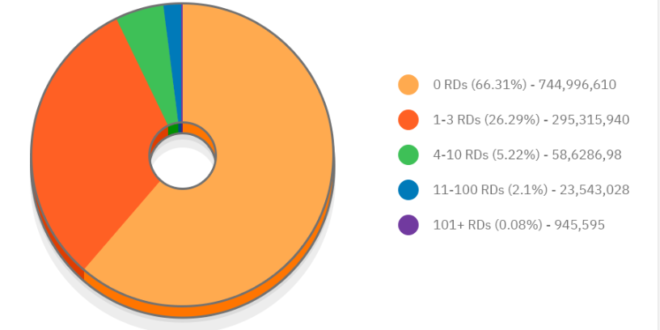Google confirmed backlinks are one of the top three ranking factors.
However, 66.31% of web pages don’t have any backlinks.
Thus, professional high-quality link-building services can place your website ahead of about 67% of web pages.
The question now is how to build those coveted high-quality backlinks. That’s what this article is going to help you with.
In the next five minutes, learn 8 ways of building high-quality backlinks:
- Linkable content
- Guest posts
- Broken links on other websites
- Niche edits
- Media requests
- Content types
- Authority resource pages
- Long-form content
8 ways of building high-quality backlinks
1. Create linkable content
Google confirms it deems organic backlinks the most valuable. Here’s how to get organic backlinks:
- You create high-value content that’s clickable and shareable (Hint: an article that solves a persisting industry problem, offers a new insight, etc.)
- Another content creator comes across your content
- The other content creator uses information from and links back to your article
Here’s how you can create content that receives organic backlinks:
- Research what type of content other sites are linking to. You can use third-party tools such as Ahrefs for research
- Write long-form content as long-form content garners more backlinks.
- Use infographics; an article with infographics has a 178% higher chance to attract backlinks than other types of content
- Offer downloadable cheat sheets, worksheets, or PDFs
2. Create guest posts
If you’re asking, “What’s the best way to get high-quality backlinks for a site?”, Guest posting is one of the answers.
However, if you have multiple services or products under one niche, which one do you promote in your guest post?
The most accurate answer, no one. Opt for promoting your website as a whole in your guest posts.
Furthermore, when choosing websites to approach for guest posting, look for:
- Strong domain authority as Google prefers backlinks coming from authority websites over small blogs
- Strong editorial guidelines and standards as that translate to high quality
- The website’s relevance to your niche
- The website traffic. The more organic traffic the site receives the better
- A balanced outbound vs. inbound link ratio
3. Use broken links on other websites
No one wants broken (or dead) links on their website as dead links lead to poor user experience. Broken link building is a backlink-building strategy that allows you to use this scenario to your benefit.
Here’s the process:
- You find a broken (a.k.a. dead) link
- You recreate the dead content
- You reach out to everyone linking to the dead resource (including the site that originally created the content) and ask them to link to your recreated content instead
You can search for broken links in the below-mentioned ways:
- Search for websites that have changed names
- Search for websites that have moved to a new URL
- Search for websites that have shut down
- Search for websites that have stopped offering a service
- Search for websites that have stopped updating a resource
4. Opt for niche edits
Niche edits — also known as link insertions — are when you find a piece of content relevant to the web page you want to build links to on an authority website. Afterward, you reach out to the webmaster and request the webmaster links to your content on the article.
Niche edits are beneficial for backlink building as:
- Backlinks gained from niche edits boost your website’s SEO rankings as the link comes from an authority website
- Building such backlinks need far less time than writing a guest post or creating a linkable piece of content
- You can link to pages that otherwise won’t receive a backlink as you can choose which page to link to
5. Opt for media requests
When journalists write articles, they need expert opinions to back their arguments. The journalists reach out to media request platforms to receive the same. Thus, answering these requests is how you create high-quality links.
If you don’t know, some of the media request platforms are HARO (Help a Reporter Out), Qwoted, and JournoRequests.
Here’s how you can make sure journalists pick your answers over other webmasters:
- Reply as soon as possible (within 24 hours would be a sweet spot)
- Follow all instructions such as the required word count for the answer
- Offer informative and crisp answers. Dilute your answer with fluff and you miss the chance of getting picked up.
6. Use proven content types to generate links
Buzzsumo and Backlino conducted a study on 912 million articles and blog posts. They found that 94% of all online content never features any external link.
One of the primary reasons? Content types.
However, the study also found the below-mentioned types of content generate high-quality backlinks:
- Infographics
- Videos
- ‘Why’ posts
- ‘What’ posts
- ‘How to’ posts
- List posts
However, why do these types of content generate more backlinks? Here’s why:
- These types of content take less time to read
- These types of content are easily scannable with subheadings, lists, and bullets
- These types of content invoke curiosity
- These types of content make a specific promise to the reader
7. Choose authority resource pages
Authority resource pages are web pages where the webmaster curates a list of valuable resources and links different services and products in the list.
Thus, you can reach out to the webmaster and request the webmaster to mention your site on their lists.
However, you won’t find these pages with the search term ‘resource pages.’ Instead, search for terms such as:
- Useful resources
- Helpful resources
- Additional resources
- Further reading
Add your niche keyword with these terms and you can find the resource pages.
Afterward, send a personalized email to the webmaster with the links you’d want to be included in the lists. Show how these links and your website add value to the resource page as well.
8. Opt for long-form content
The benefits of long-form content in building high-quality backlinks:
- Backlinko confirmed content over 3,000 words receive 77.2% more referring domain links than content shorter than 1,000 words on average
- The most shared article in New York Times had over 2,000 words on average
- HubSpot confirmed blogs with word counts between 2,250 to 2,500 received the most organic traffic. If your content is getting organic traffic, webmasters will be more interested in linking your content.
Here’s why long-form content performs better than short-form content when it comes to building high-quality links:
- A well-written piece of long-form content answers all the questions readers have on the topic; something a piece of short-form content can’t offer
- Long-form content receives more social media shares than short-form content as well
- Google’s RankBrain algorithm prefers long-form content over short-form content. The reasons behind this preference include how much time users spend on the site and click-through rate (long-form content receives higher click-through rates)
Build high-quality backlinks — an essential search ranking factor
The web page that ranks first in Google has 3.8x more backlinks than web pages with positions from 2 to 10.
Thus, building high-quality backlinks is an essential search ranking factor.
The tips shared in this article will let you know how to create high-quality backlinks. Use the information to grow your affiliate site.
 HammBurg Be informed with latest news, reviews, entertainment, lifestyle tips, and much more.
HammBurg Be informed with latest news, reviews, entertainment, lifestyle tips, and much more.



